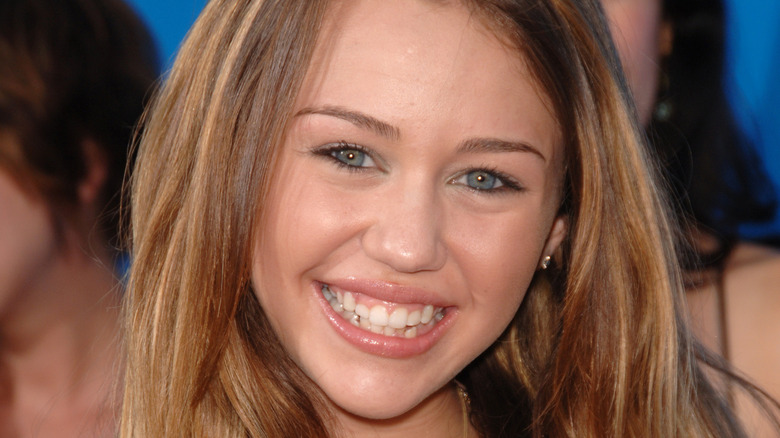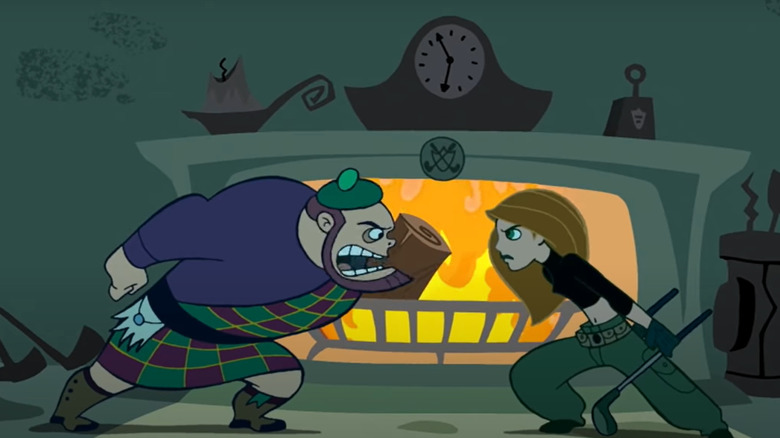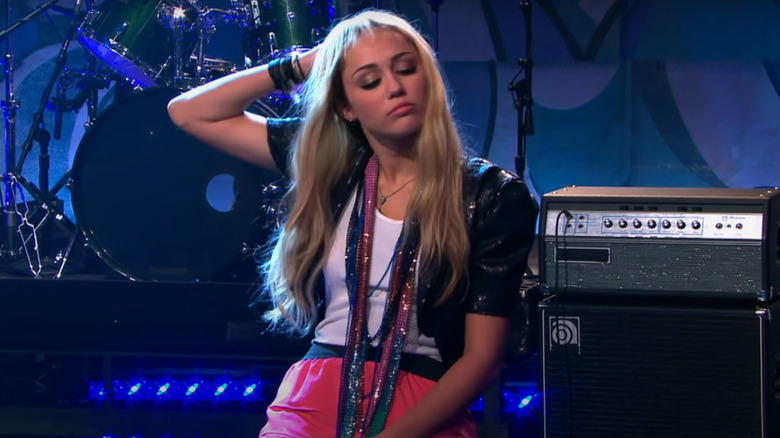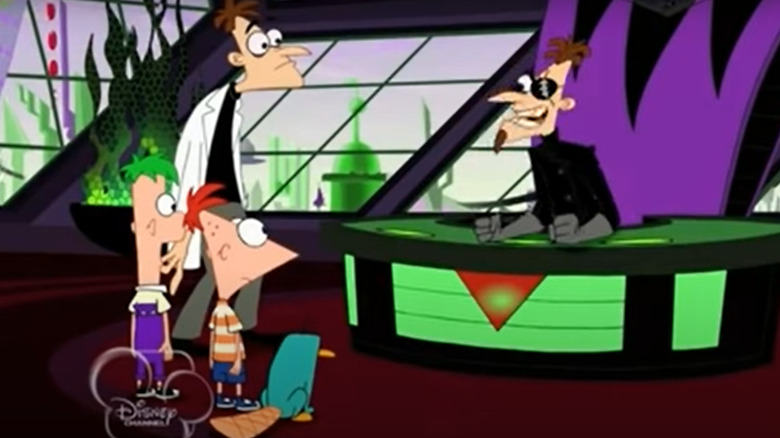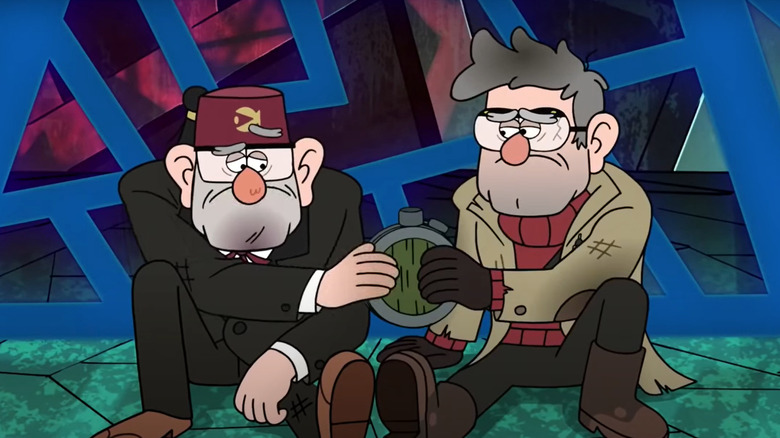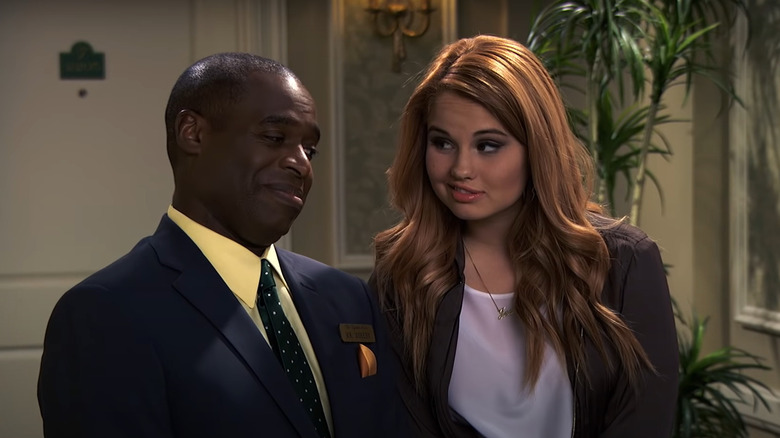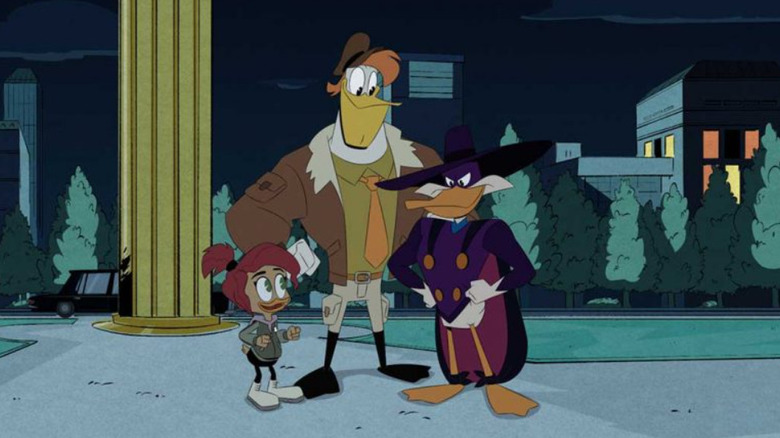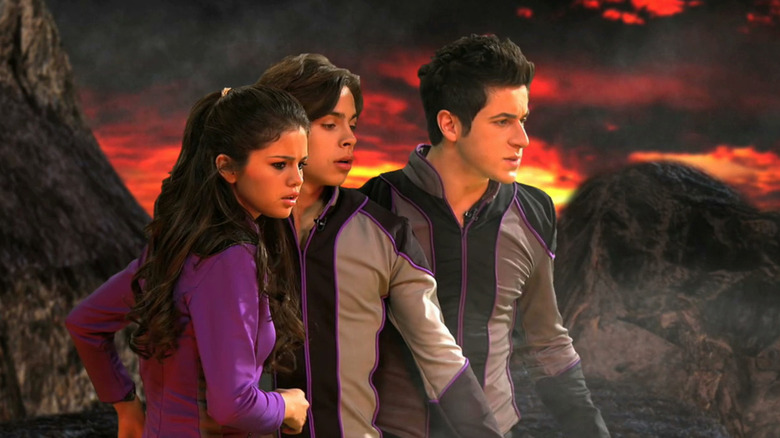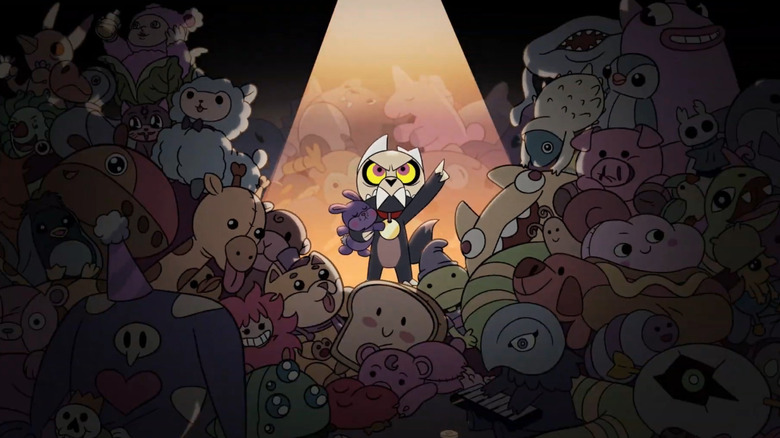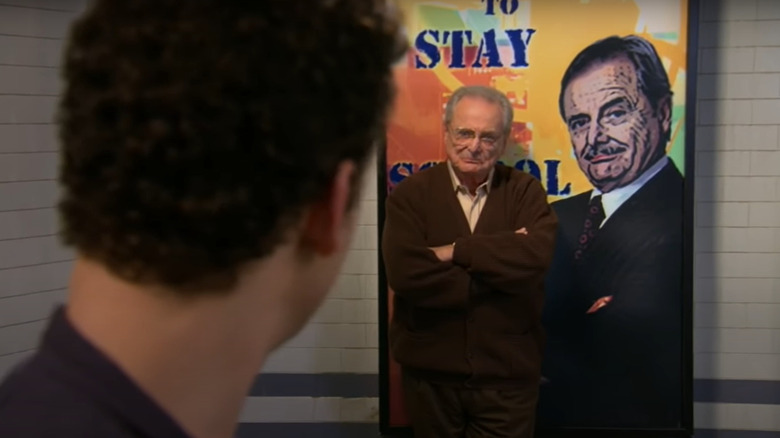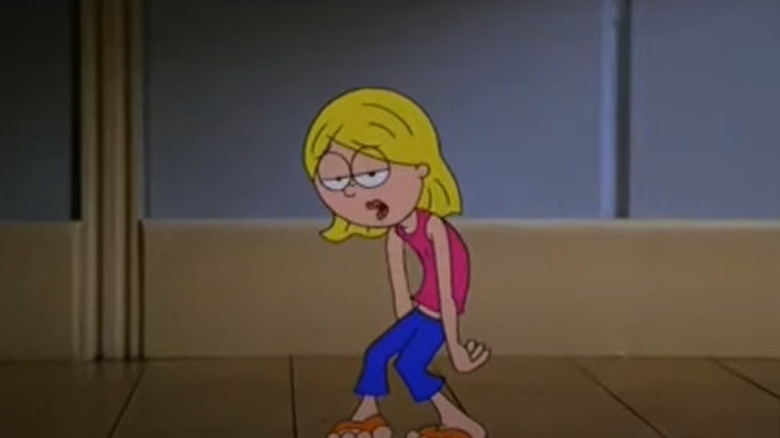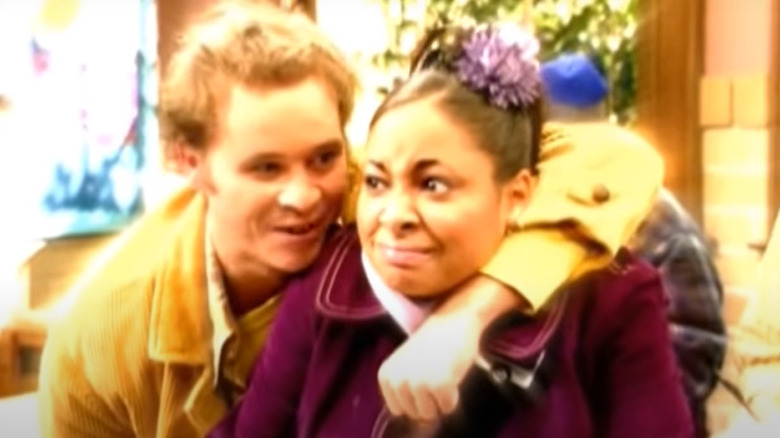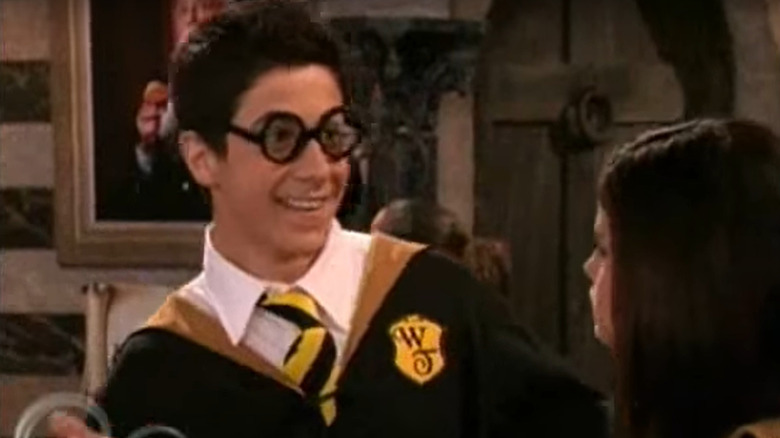Theories About Disney Shows That Change Everything
Disney entertainment has long been seen as the bastion of good, clean family fun. The Disney channel makes good on this public image by going to great lengths to ensure its shows are free of any kind of objectionable material. Sometimes this approach can lead to the channel's content being termed too "vanilla," but the enduring popularity of so many Disney shows is a testament to how well the Mouse Empire's formula works.
Of course, the content that the studio pumps out is only one half of the equation. The other half is comprised of the fans who eagerly consume each new episode, holiday special, and made-for-tv movie based on their favorite shows. This kind of devotion can take fandoms in strange new directions that the original creators of the show might never have dreamed of.
Over the years, fans have come up with a range of theories regarding their favorite Disney shows. Some of those theories are minor additions to the show's canon in the minds of fans, while others can dramatically shift your entire understanding of the storylines and characters. Here are 14 such theories about Disney shows that will send your mind reeling.
Kim Possible is a genetically-enhanced soldier
The Set Up: The titular character in "Kim Possible" (2002-2007) is, in her own words, a "basic, average girl" who spends her time going to school, attending cheerleading practice, and hanging out with her best friend Ron. On the side, Kim is also a world-renowned crime-fighter who has kicked the butts of supervillains, aliens, and magical deities in equal measure.
The Theory: No matter how big an opponent Kim faces in her adventures, she is always able to get the best of them with some shrewd kicking and punching. Considering she is a fashionably slim high-school girl, there is no way her kicks or punches should register in any major way against towering thugs who often attack Kim in groups.
The fact that Kim is able to knock out multiple opponents has led fans to surmise that she might be a genetically-enhanced super soldier similar to Captain America. After all, Kim's mom and dad are a brain surgeon and a rocket scientist. That's more than enough brain power between them to cook up a super strong daughter similar to what Professor Utonium did with the Powerpuff Girls. This would also help explain why Kim's parents never seem overly concerned about the danger posed to their daughter on one of her spy missions. It's because her parents know Kim is far from an ordinary girl whom the villains can knock around willy-nilly.
Hannah Montana is a hollow disguise
The Set Up: In "Hannah Montana" (2006-2011), Miley Stewart (Miley Cyrus) is an ordinary girl who moonlights as pop singing sensation Hannah Montana. With the help of her understanding family, a blonde wig and a slight change in accent, Miley is able to live two lives as a superstar singer and a regular high-schooler.
The Theory: Right from the first episode, it is clear that Miley has the worst disguise this side of Clark Kent. A simple blonde wig and fake accent is certainly not enough to hide your height, eyes, bone structure, voice, and body type from people who have known you your whole life. Yet, somehow Miley is able to fool her best friends, her fellow high-schoolers, and even adults into thinking Miley and Hannah are separate people.
But what if Miley isn't actually fooling anyone? What if everyone around her is only pretending to go along with her deception to give Miley the illusion of normalcy, in a glittery, sequined version of "The Truman Show?" We know Hannah makes a lot of money that her father controls. It might be possible for her father to use the money to set up a giant operation that involves a bunch of actors, just so his daughter is able to live something resembling normal life and not be overwhelmed by the pressures of pop stardom.
Dr. Doofenshmirtz is Phineas' dad
The Set Up: In "Phineas and Ferb" (2008-2015), the titular characters are two wildly inventive, intelligent step-brothers who build all manners of impossible contraptions to pass the time during their summer vacations. In the same tri-state area, the evil Dr. Doofenshmirtz wages a separate battle against a secret agent platypus who wants to stop him from taking over the tri-state area using his impossibly-advanced machines.
The Theory: At first glance, it can be difficult to see where Phineas and Ferb get their brains from. Ferb's dad and Phineas' mom are nice people, but they are far from brainy masterminds. In fact, the closest thing we see to the brains and imagination displayed by the brothers is in the evil "inators" that Doofenshmirtz makes in pursuit of his plans for tri-state domination.
Another major similarity is that both Doofenshmirtz and Phineas have highly-distinctive triangle-shaped heads. We also know that Phineas' mom and Doofenshmirtz briefly dated in their youths. All these factors have led fans to theorize that Phineas is actually Doofenshmirtz's son, and the heir to the evil doctor's giant intelligence. It is also interesting to note that Phineas briefly dressed up as an evil scientist archetype while trying to help scare the hiccups out of Isabella in "One Good Scare Ought To Do It!" That episode seemed to further highlight the similarities between the two characters.
Rick and Morty is an alternate version of Gravity Falls
The Set Up: "Rick and Morty" (2013-Present) and "Gravity Falls" (2012-2016) have had quite a few sneaky crossovers, from objects on one show appearing on the other to a secret message in a "Gravity Falls" journal spelling out "Rick was here." It is also hinted that Rick and Stanley Pines have worked together in the past, both being genius scientist adventurers who traverse the multiverse.
The Theory: We know Rick has a vast army of clones/doppelgangers/genetically-similar lookalikes in other realities. We also know that Rick is always in search of an elusive happiness by trying to remove the toxic aspects of his personality. What if "Gravity Falls" is one such reality where Rick actually did manage to successfully separate his good side from his bad, leading to the creation of twin brothers Stanley and Stanford, complete with a false set of memories?
Both Stans have striking similarities to Rick. Stanford is just as intelligent, curious, and resourceful, while Stanley is just as big a con man, and just as rude, selfish, and a heavy drinker. Despite their differing personalities, both brothers share a deep bond, and eventually learn to set their differences aside to work together as they explore the world side-by-side. Could it be that somewhere in the multiverse Rick is watching the two Stans with pride, and trying to learn from their successful experiment to reconcile the warring aspects of his own personality?
Bailey Pickett and Jessie Prescott are the same person
The Set Up: Debby Ryan's first notable Disney role was as Bailey Pickett in "The Suite Like on Deck" (2008-2011). Ryan later starred in her own Disney show "Jessie" (2011-2015) as Jessie Prescott. Jessie is confirmed to be set in the same universe as "The Suite Life on Deck," since Phill Lewis reprised his role as Mr. Moseby from the show on "Jessie" and even remarked on how closely Jessie resembles Bailey.
The Theory: At the end of "The Suite Life on Deck," Bailey gets her acceptance letter from Harvard, but her boyfriend Cody (Cole Sprouse) does not. So Bailey prepares to leave for Harvard alone. What if Bailey had not received an acceptance letter either? After all, she and Cody are shown to be extremely similar in their academic accomplishments. What if Bailey was too ashamed to come clean to Cody about her rejection letter from Harvard — and by the time she found out Cody had been rejected as well, it was too late to admit to her lie?
We already know Bailey is quite comfortable with lying and subterfuge, since she is introduced pretending to be a male student in "The Suite Life on Deck." It is possible that by the end of the show, instead of going to Harvard like Cody expected her to, Bailey once again changed her identity, this time to Jessie Prescott. She then moved to New York at the start of Ryan's other show.
Darkwing Duck is Scrooge's son
The Set Up: In Disney's "Duckverse," Drake Mallard (aka Darkwing Duck) is the heroic protector of the city of St. Canard. Armed with a host of gadgets, his sidekick and pilot Launchpad McQuack, and impressive physical skills, Darkwing Duck wages a lonely war against the villainous elements of his city that seek to destroy the lawful order of things.
The Theory: Drake Mallard is a bit of an anomaly in the "DuckTales" universe of which he is a part. While other characters in the series tend to be bumblingly comedic, Drake is shown to be remarkably adept at pulling off daring feats of strength and courage when the occasion calls for it. In fact, there is only one other character in the entire "Duckverse" who shares the same traits to such an extent: renowned fortune hunter and adventurer Scrooge McDuck. We also know that the "Mallard" family is directly related to the McDucks as imagined by celebrated Disney writer Don Rosa.
What if Drake is Scrooge's secret heir, and Scrooge recognized his own spirit of adventure in Drake? That could mean it is Scrooge who is secretly funding Drake's war on crime. That would also explain Scrooge sending his trusted pilot Launchpad to Drake as a sidekick. All that remains, it seems, is a "Batman Begins"-style series with Scrooge acting as an older, grizzled Bruce Wayne and Drake as the eager new Batman.
Using magic causes brain damage
The Set Up: In "Wizards of Waverly Place" (2007-2012), siblings Alex (Selena Gomez), Justin (David Henrie) and Max (Jake T. Austin) are typical New York teenagers secretly training to become magicians. The three characters have to keep up with their wizard training and simultaneously resist the urge to use magic as a short cut to get anything they want.
The Theory: The series starts with the siblings as reasonably average teenagers in terms of their intelligence. But as the show continues, Alex and Max begin to get noticeably dumber. Their schemes became increasingly zany, and it seems like they are putting less effort into their plans and hijinks.
Interestingly, Justin did not suffer from this "dumbing down" over time. Some theorize the reason behind this is that relying too much on magic causes brain damage in young wizards. After all, Max and Alex are shown to be very eager to use magic as frequently as they can get away with, while Justin is much more careful, and prefers to come up with non-magic solutions. Perhaps this reluctance to get too involved with magic allowed Justin's brain to escape the damage inflicted on Alex and Max over the years.
King is Bill Cipher's reincarnated form
The Set Up: In "The Owl House" (2020-Present), King Clawthorne is a tiny, high-strung furry monster and the main character's sidekick. Despite his adorable appearance, King often speaks in a manner that hints at a dark and fearsome past, made all the more unsettling because he is voiced by Alex Hirsch, creator of "Gravity Falls," who also voiced the fearsome Bill Cipher on that show.
The Theory: Bill Cipher was a great Disney villain, a terrifying dream demon, expert manipulator and reality warper. Although Bill seemed to have died at the end of "Gravity Falls," evidence points towards the possibility that the character did not actually pass on, but was rather reincarnated in another form.
What if King is Bill's reincarnated form? Aside from the fact that Hirsch voices King in an almost identical manner, part of Bill's deal for getting a reincarnation was that he would atone for his sins in his new form. This neatly fits Bill's motivations post reincarnation, with King appearing to be a former villain now trying to do good.
Mr. Feeny is a guardian angel
The Set Up: In "Boy Meets World" (1993-2000), Cory Matthews (Ben Savage) attempts to navigate school life with the help of his compassionate, worldly-wise teacher Mr. George Feeny (William Daniels). Originally shown to be Cory's sixth grade teacher, Feeny was later retconned to be Cory's teacher from first grade. He eventually became the principal of John Adams High, keeping a watchful eye on Cory and his friends at school, and then as Cory's neighbor in later seasons.
The Theory: Feeny's presence has been a constant factor in Cory's life since he started school. Whenever Cory needs advice to navigate this way through life, Feeny is always on hand to deliver sound advice. In later seasons, when there is no reason for Cory to still hang out with his sixth grade teacher, things almost magically rearrange themselves so Feeny can continue to watch over Cory and advise him.
Feeny's presence even carried over to the spinoff show "Girls Meets World" (2014-2017), which had a grown-up Cory attempting to provide his daughter with life lessons. At the end of the first episode of the show on a subway station, Cory sees Feeny standing nearby smiling at him, before suddenly disappearing. All these facts have led some fans to surmise that Feeny is Cory's guardian angel, one who will always manage to be there whenever Cory needs assistance.
Milo Murphy is being hunted by Death, a la Final Destination
The Set Up: In "Milo Murphy's Law" (2016-2019), the main character Milo is a direct descendant of the creator of Murphy's Law which states that "Anything that can go wrong will go wrong." Milo is frequently on the receiving end of catastrophic bad luck, which he overcomes through a positive attitude and a backpack full of pre-planned preparedness.
The Theory: The idea that a person could be subjected to bad luck on a frequent basis can be seen in action in the "Final Destination" horror franchise. In that series, Death itself hunts down individuals who have escaped its grasp by subtly influencing events to bring about the deaths of the main characters. All through the franchise, characters are subjected to near-death or downright fatal accidents that look like horrifically bad luck to outsiders. Sound familiar?
What if Milo (and other members of his family) are similarly being hunted by Death? If, over time, Milo's family has devised ways to keep cheating Death, it would explain Milo's backpack that manages to help him escape any gruesome catastrophe. The backpack was given to Milo by Veronica, his old babysitter, who was the only one able to handle Murphy's Law. Perhaps Milo is the one character in an extended "Final Destination" universe who has figured out how to survive; with a positive attitude and obsessive preparation against anything Death can throw at him he has thus far lasted even longer than Ali Larter.
Lizzie Maguire is schizophrenic
The Set Up: In "Lizzie Maguire" (2001-2004), the titular character, played by Hillary Duff, gives audiences a peak into the inner workings of a teenage girl's mind as she attempts to navigate high school life via fourth-wall breaking monologues. The monologues are delivered by a cartoon version of Lizzie, who frequently addresses the audience regarding her state of mind.
The Theory: Theorizing that a character suffers from mental illness is one of the laziest forms of fan theories, right alongside "it was a dream all along," and "x character was just a figment of another character's imagination." But in the case of Lizzie Maguire, the theory that she suffers from schizophrenia comes with some rather compelling evidence. Those who suffer from the condition interpret reality abnormally. This can result in a combination of hallucinations, delusions, and acting out in public.
Cartoon Lizzie is a voice in the real Lizzie's head that appears to have a personality of its own. The behavior of cartoon Lizzie is often at odds with the real Lizzie, and the more upset real Lizzie gets, the more hyper and volatile the actions of cartoon Lizzie become. There are even those who theorize that Lizzie's best friend Miranda (Lalaine Vergara-Paras) is also a figment of Lizzie's schizophrenic imagination. Lizzie invented Miranda to help her deal with middle school. For the next few years Lizzie took her meds, and so Miranda disappeared by the time Lizzie entered high school.
Raven is guided by an evil deity
The Set Up: In "That's So Raven" (2003-2007), the titular character Raven Baxter (Raven-Symoné) is a teenager who has psychic abilities. Despite being able to look into the future on certain occasions, Raven is often unable to help those around her, or prevent an unfortunate accident from taking place due to misunderstanding the context of her visions.
The Theory: Even though Raven has psychic abilities, she does not have a lot of control over them. The flashes that Raven gets of future events are usually incomplete and out of context. Like the time she saw a vision of her father Victor (Rondell Sheridan) telling his wife "we need to split up." Raven assumed her father was talking about a divorce, but it transpired that Victor was talking about splitting up to search for a ring.
Such misunderstandings occurred frequently on the show, which led to theories that Raven's visions are granted to her by a malevolent deity who enjoys watching the young girl get confused and act out in the wrong manner. If you want to get really meta-textual, the malevolent deity could be the show's writers, who send Raven on hare-brained schemes based on her visions, simply for the cruel amusement of the audience.
Voldemort won in the Wizards of Waverly Place universe
The Set Up: "Wizards of Waverly Place" was obviously inspired by the "Harry Potter" series. In the episode "Wizard School Part 1" (Season 1, Episode 13), Alex, Justin, and Max attend a magical school in the summer clearly meant to be Hogwarts, but called "WizTech." When Justin puts on round glasses and wizarding robes, Alex says he reminds her of someone named "Barry something... Larry something... oh, never mind."
The Theory: Clearly, the adventures of Harry Potter at Hogwarts and his fight against Voldemort carry some currency in the wizarding world of "Wizards of Waverly Place." But in this world, Hogwarts is now called WizTech, it is run by a new batch of teachers, Dumbledore is nowhere to be found, and Harry's name is virtually forgotten. What if "Wizards of Waverly Place" takes place in an alternate reality where Voldemort killed Harry Potter and remade the wizarding world in his image, starting with a complete overhaul of Hogwarts?
There are other hints that "Wizards of Waverly Place" takes place in a world where Voldemort's "pure blood" wizard supremacist ideology is alive. As explained by TV Tropes, "Leprechauns are kept in cages to gawk at, elves get named based on what job they're going to have, and tutors aren't ever allowed to revisit the family they worked with again." All these signs point towards Voldemort having succeeded in making the wizarding world a wicked place for everyone but pure-blood wizards.
